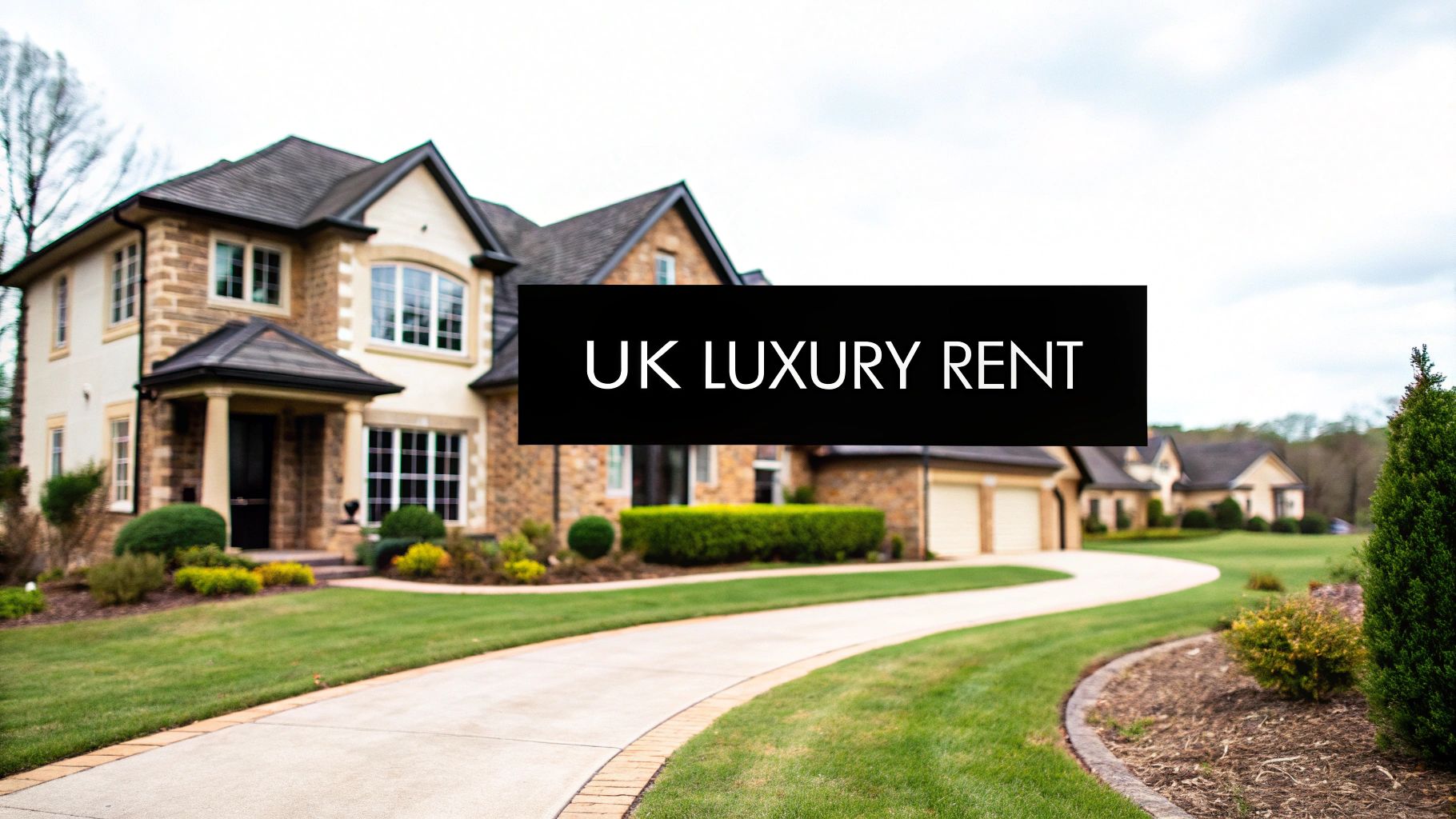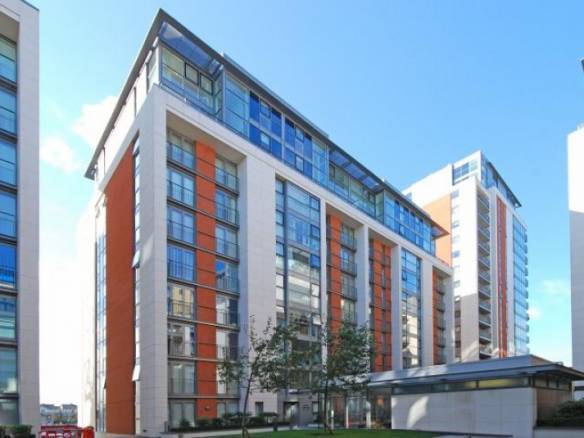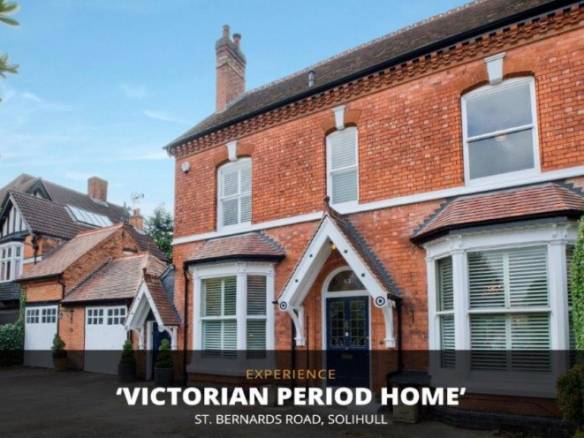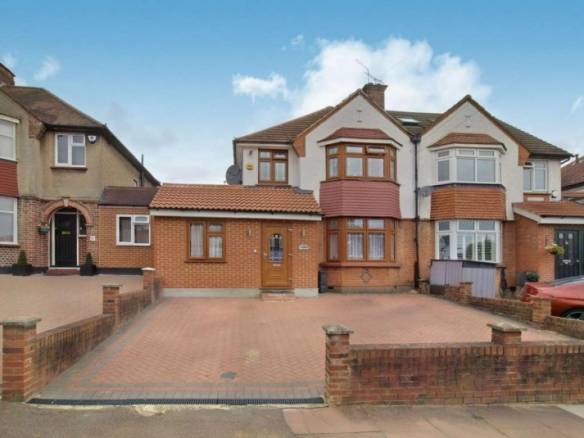Stepping into the UK’s luxury rental market isn’t just about finding a place to live; it’s about securing a specific lifestyle. The search for a luxury house to rent in the UK goes far beyond the price tag. It’s a pursuit of premium amenities, exceptional service, and the prestige that comes with a coveted postcode. From London’s prime boroughs to sprawling country estates, this guide is for the discerning individual seeking their next home.
Understanding the UK’s Prime Rental Market
The high-end rental sector in the United Kingdom operates on its own terms, quite separate from the mainstream property market. It’s a global stage, attracting senior executives on corporate relocations, high-net-worth families chasing proximity to top-tier schools, and even those wanting to ‘try before they buy’ in an exclusive neighbourhood. Getting to grips with this landscape is your first, most crucial step.
Unlike a standard rental, a luxury property is defined by a collection of exceptional traits. These aren’t just houses; they are meticulously curated homes. Every detail, from the architectural vision and interior design to the integrated technology, is executed to the highest possible standard.
What Defines a Luxury Rental Property?
The word ‘luxury’ gets thrown around a lot, but in the UK’s prime property market, it’s measured by several key factors:
- Prime Location: This is paramount. A prestigious postcode in an area like London’s Kensington, Mayfair, or Belgravia, or a highly sought-after rural spot in the Cotswolds or Surrey, will always command a significant premium.
- Exceptional Quality and Finish: Think superior construction, high-end materials like marble and hardwood, bespoke joinery, and appliances from leading brands that you’d recognise instantly.
- Exclusive Amenities: This is where properties truly stand apart. We’re talking private cinemas, state-of-the-art gyms, indoor swimming pools, professionally landscaped gardens, and secure underground parking. In apartment buildings, this extends to 24-hour concierge services, residents’ lounges, and dedicated security teams.
- Space and Privacy: Generous square footage is a given, but it’s the well-designed layouts and genuine sense of seclusion—achieved through private grounds or clever architecture—that really count.
The Current Market Climate
Demand to rent a luxury house in the UK is robust, fuelled by both domestic and international interest. While London remains the epicentre, we’re seeing regional hotspots gain serious traction.
One of the biggest trends is the demand for ‘turnkey’ properties. These are homes that come fully furnished and equipped to a high specification, allowing tenants to move in with just their suitcases. It’s an incredibly appealing option for international clients and professionals on fixed-term assignments who value a seamless transition.
Nick Marr, founder of EuropeanProperty.com, observes, “The prime UK rental market is less about necessity and more about choice and experience. Clients are not just renting a space; they are investing in a lifestyle, security, and convenience for a specific period. The best properties offer a seamless transition into that desired life.”
This insight is vital. You’re entering a sphere where relationships with specialist agents, discretion, and a clear grasp of what constitutes true value are more important than ever. As you start your search, remember to think beyond the property itself and focus on the complete lifestyle package it offers.
Decoding the Dynamics of the Prime Rental Market
What really drives the cost and availability of high-end homes in the UK? When you’re looking at the prime rental market, it’s not just about simple supply and demand. It’s an entire ecosystem, shaped by global business, personal aspirations, and the simple fact that truly exceptional properties are incredibly rare.
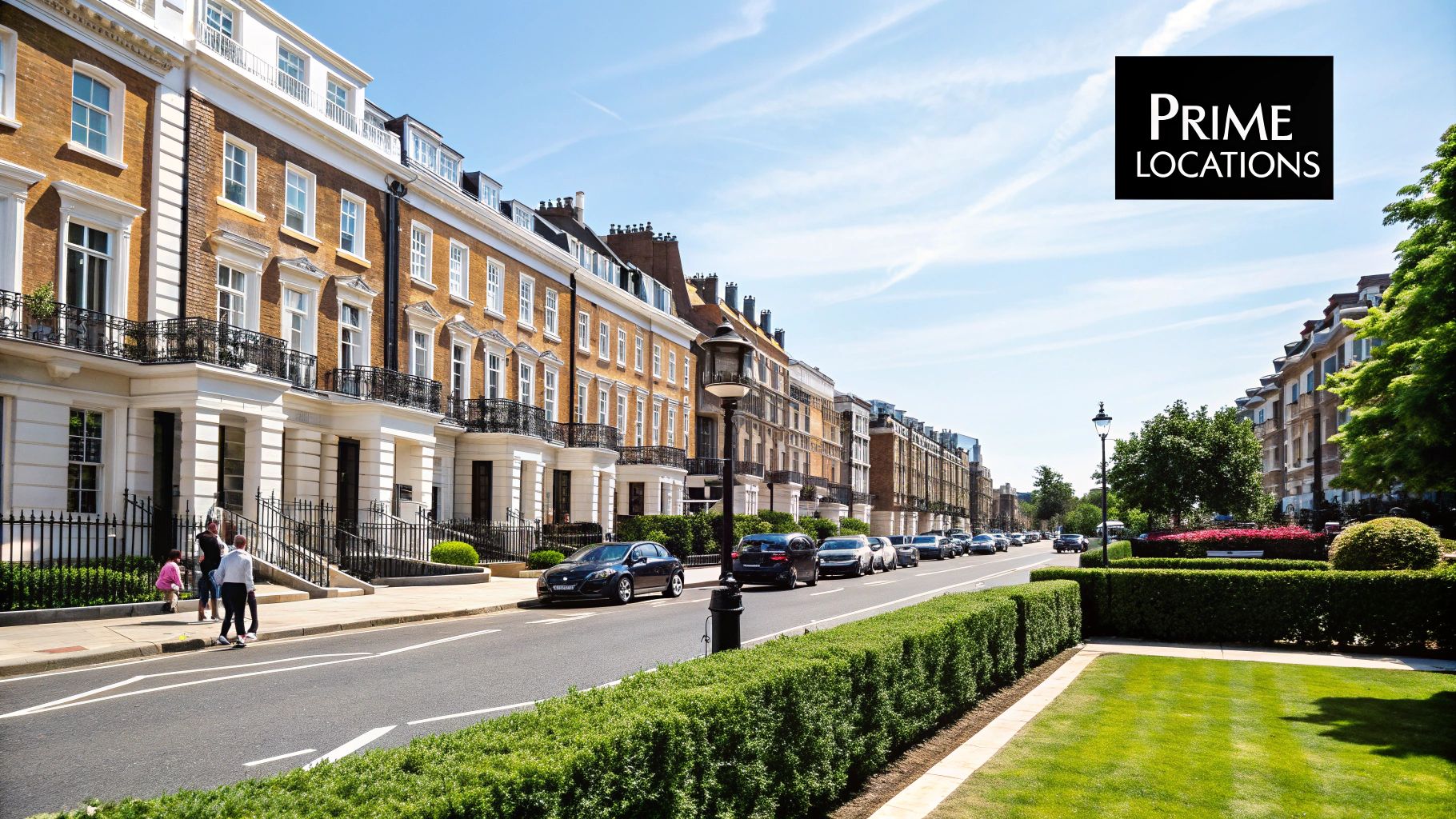
The forces at play in the luxury house rent UK market are quite different from the rest of the rental sector. They reflect the very specific needs of a discerning, often international, clientele.
The Influence of International Executive Relocations
A significant driver of demand comes from the constant flow of senior executives and diplomats moving to UK business hubs, especially London. Major corporations, financial institutions, and tech firms are always relocating top talent for assignments that can last several years.
These individuals and their families aren’t just looking for a house; they need a premium, secure home that’s ready to go, often fully serviced. They require a base that supports a high-pressure lifestyle, close to top international schools, business districts, and transport links. This steady stream of corporate demand creates a reliable, high-value tenant base that keeps rental values strong in prime postcodes.
The ‘Try Before You Buy’ Mindset
Another key trend is the ‘try before you buy’ approach. High-net-worth individuals, whether moving from abroad or relocating within the UK, often choose to rent for a year or two before committing to a multi-million-pound purchase. It’s a strategic move, allowing them to truly get to know a neighbourhood, assess commutes, and ensure the area fits their lifestyle before making a significant financial commitment.
This trend is especially common in areas with a strong community feel and unique character, like Notting Hill in London or the charming villages of the Cotswolds. It keeps the demand for the very best rental properties consistently high, as these tenants are essentially auditioning a location for their long-term future.
Scarcity and the Postcode Premium
Perhaps the most fundamental driver of all is the finite supply of top-tier properties. There is simply a limited number of homes that meet the strict standards of the luxury market in terms of location, size, quality, and amenities. This natural scarcity drives rental values up, particularly for properties that offer something unique—think a large private garden in central London or direct river access on a country estate.
This is where the postcode premium comes into play. The address itself carries enormous weight:
- Proximity to Elite Schools: Being in the catchment area for a world-renowned school can add a serious premium to a rental property.
- Enhanced Security: Postcodes known for low crime rates and excellent private security are always in high demand.
- Prestige and Exclusivity: Certain addresses possess a social currency that commands a premium.
Taken together, these factors create a market where rental growth is incredibly robust. Recent data from the Office for National Statistics illustrates this, showing consistent rental price growth across the UK. In London, the heart of the prime market, boroughs like Kensington and Chelsea command the highest average monthly rents, often exceeding £3,500. You can explore the full UK property price history to see these trends yourself. For landlords, a well-located luxury property is a fantastic asset. For tenants, it’s the price of admission to one of the UK’s most desirable lifestyles.
Exploring Top Regional Hotspots for Luxury Living
When you think of UK luxury property, London naturally dominates the conversation. But the truth is, the high-end rental market stretches far beyond the capital, offering a surprisingly diverse landscape for discerning tenants.
This means you have a wealth of choice, whether you’re dreaming of a historic city townhouse, a sprawling country manor, or a secluded coastal retreat. Digging into these regional hotspots is about more than just finding a prestigious address; it’s about aligning your lifestyle with the perfect location.
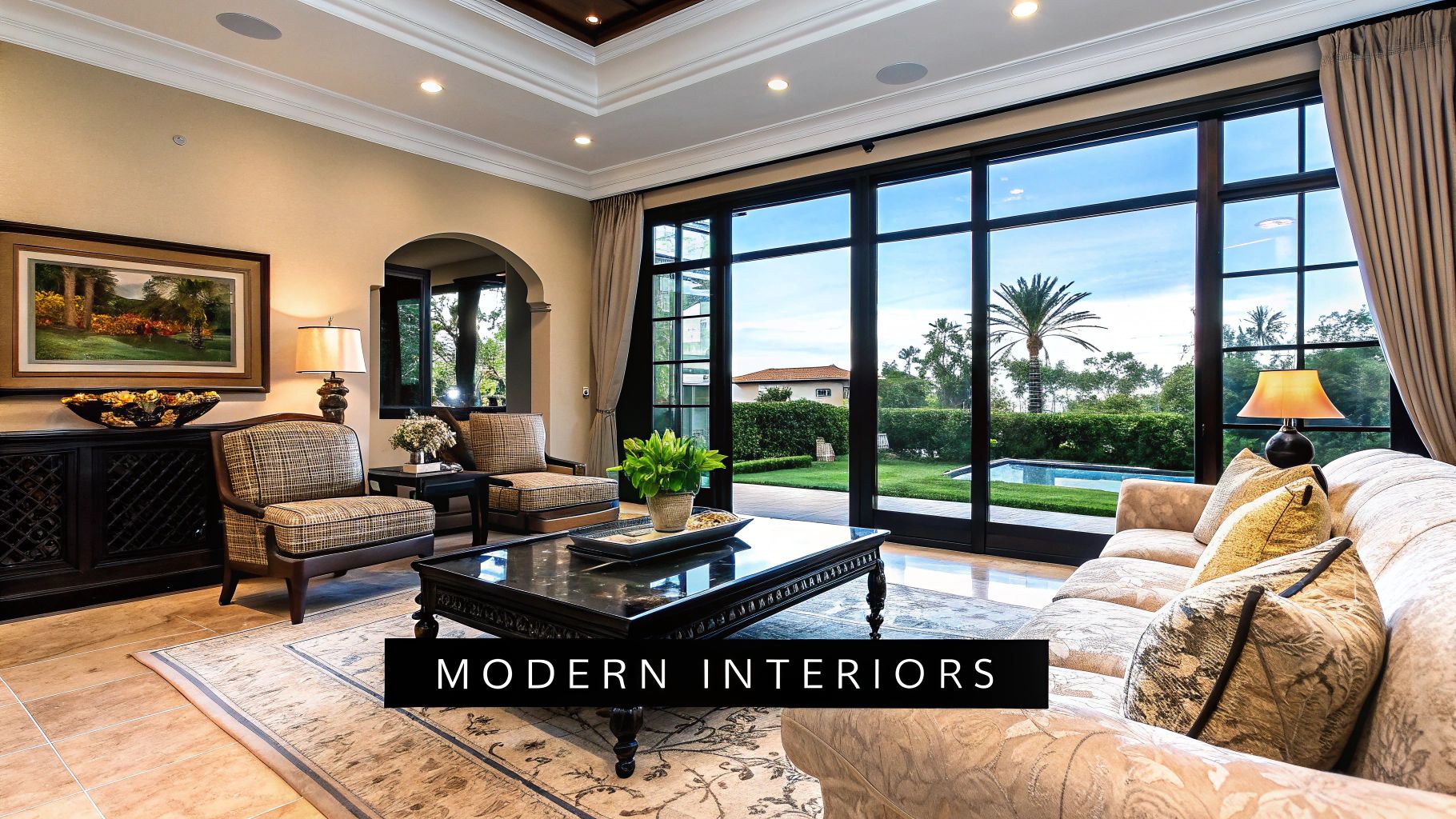
Let’s explore some of the most sought-after areas to find a home that isn’t just a rental, but a genuine fit for the life you want to live.
The Home Counties: Idyllic Countryside Living
Just outside London, the “Home Counties”—think Surrey, Berkshire, and Hertfordshire—offer the quintessential English country lifestyle without sacrificing connectivity to the city. These areas are renowned for their magnificent country estates, historic manors, and grand family homes, often nestled within acres of private, landscaped grounds.
- Who Rents Here: You’ll find affluent families drawn by the top-tier independent schools, senior executives seeking a peaceful escape from city life, and international clients who prioritise space and privacy.
- Property Style: Expect everything from classic Georgian and Tudor architecture to striking contemporary new-builds. Many come with premium features like equestrian facilities, tennis courts, and swimming pools.
- Lifestyle: The appeal lies in the balance. It’s a tranquil, village-centric life with charming local pubs and community events, yet you’re only a short train ride from London’s business and cultural heart.
Tenants in the luxury market rightly expect all aspects of the property to be in perfect working order. This includes the heating and hot water systems, which should be both powerful and reliable. Landlords of high-end properties typically ensure this by having their systems maintained by a specialist heating engineer, guaranteeing that issues are resolved quickly and that the boiler is running safely and at peak efficiency for maximum comfort.
The Cotswolds: Timeless Charm and Sophistication
Famed for its gentle, rolling hills and picture-perfect, honey-coloured stone villages, the Cotswolds is an Area of Outstanding Natural Beauty that has long been a magnet for high-net-worth individuals. Renting here is an invitation to embrace a slower, more refined pace of life amidst some of England’s most stunning scenery.
The region offers a unique mix of rustic charm and understated elegance. Properties range from beautifully restored farmhouses and listed manor houses to sleek barn conversions. It’s a favourite for those looking for a weekend bolthole or a permanent base away from the urban hustle. You can often find incredible examples, like this beautifully appointed Cotswolds-style home, that perfectly capture the area’s architectural soul.
The ‘Golden Triangle’ of Cheshire
Up in the North West of England, Cheshire’s “Golden Triangle” is an affluent pocket encompassing towns like Wilmslow, Alderley Edge, and Prestbury. It’s a well-known hotspot for professional footballers, entrepreneurs, and media personalities.
The rental market in the Golden Triangle is all about modern, high-spec properties that deliver on both glamour and security. These are homes built for entertaining and a high-profile lifestyle. They are often contemporary mansions kitted out with the latest home automation, advanced security, and incredible leisure facilities like private cinemas and bespoke wellness suites. The area has a vibrant social scene to match, with designer boutiques, exclusive restaurants, and a palpable energy that attracts a younger, high-earning crowd.
Thriving Northern Hubs and Historic Cities
It’s not just about traditional country enclaves anymore. Dynamic cities like Manchester are now serious contenders in the prime rental market. The city’s buzzing rental scene is thriving, powered by a young professional demographic and strong employment.
And it doesn’t stop there. Cities like Edinburgh and Bath offer their own unique appeal. Edinburgh delivers historic grandeur alongside a world-class cultural scene, while Bath’s elegant Georgian architecture and spa heritage create a sophisticated living environment. These cities are perfect for tenants who want a rich cultural life and architectural beauty, offering a compelling alternative to both London and the quiet countryside.
Finding Your Way Through the Luxury Rental Process
Renting a high-end property in the UK is a more involved, structured journey that calls for greater attention to detail. To go from browsing online to unlocking the door of your new home, you need to understand the key steps.
It all starts with engaging a specialist letting agent who lives and breathes the prime property market. These agents are your key to exclusive, often off-market properties and offer invaluable advice. From there, you’ll move through viewings, making an offer, and clearing referencing checks before any contracts are signed.
This visual guide breaks down the core stages, making the entire journey more transparent.
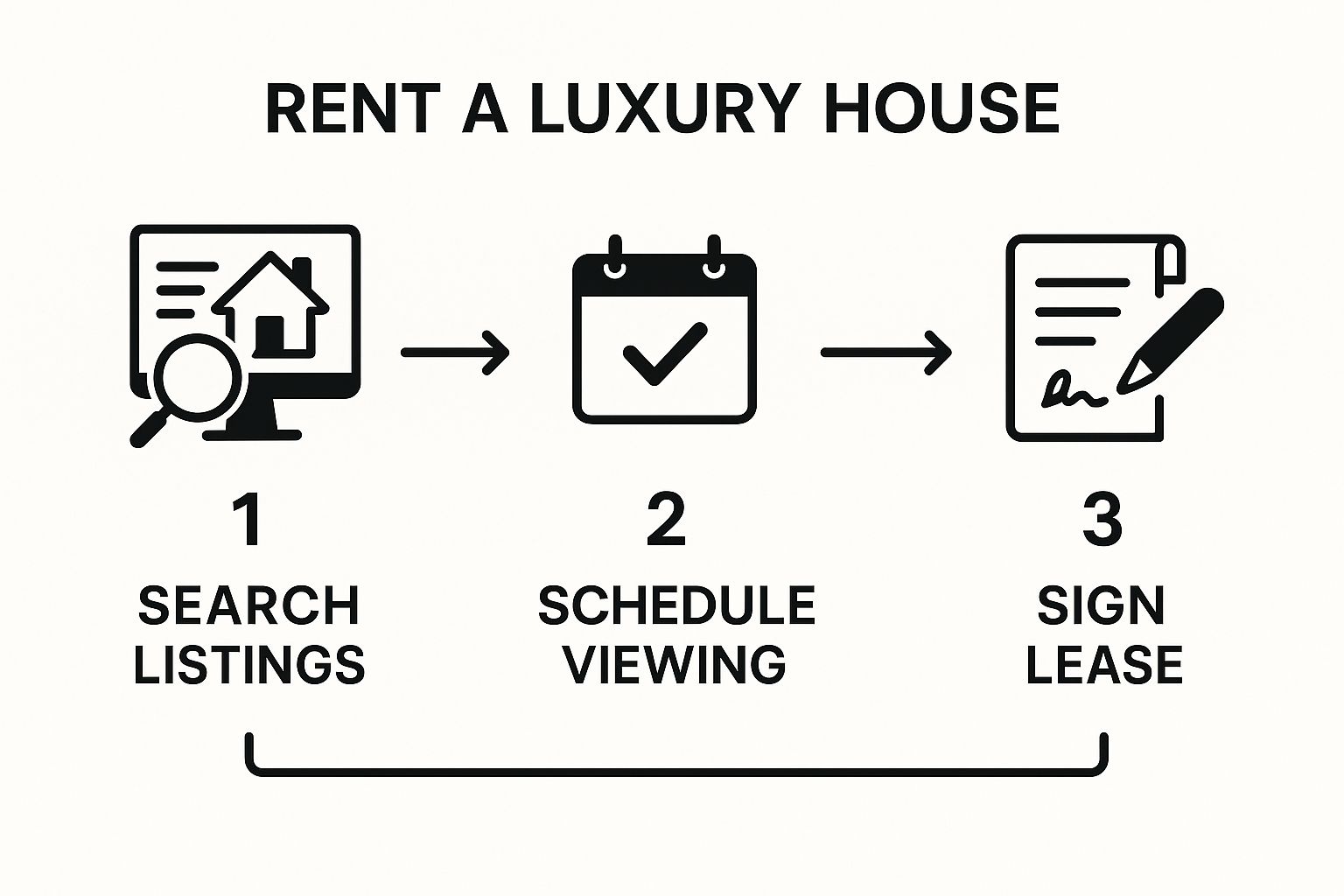
As you can see, it’s a logical path. Each step builds on the last, ensuring everything is handled correctly for a smooth and secure tenancy.
Engaging Specialist Agents and Arranging Viewings
Your first move should be to partner with a letting agent who specialises in prime residential property. These are the experts with a portfolio of high-calibre homes and a deep understanding of what high-net-worth clients require. They will act as your trusted advisor, shortlisting properties that meet your specific criteria.
Once you have a shortlist, the viewings begin. For international clients, high-quality virtual tours have become standard and offer a fantastic first impression. However, nothing replaces an in-person visit. We always recommend a physical viewing before you commit—it’s the only way to get a true feel for the property’s scale, finish, and atmosphere.
Mastering Negotiations and Offers
Found the perfect property? The next step is making an offer. In the luxury sector, this is about more than just a figure; it’s a proposal that positions you as the ideal tenant.
Your offer should clearly state:
- The monthly rent you’re proposing.
- Your preferred tenancy start date and lease duration.
- Any specific conditions, such as requests for certain furnishings to be added or removed.
- A brief, professional profile of who will be living in the property.
A strong, clear offer presented by your agent signals you’re serious and sets a professional tone. Landlords in this market are not just looking for the highest rent; they prioritise reliable, long-term tenants. A well-constructed offer can be just as persuasive as the price itself.
Understanding Referencing and Legal Agreements
Once your offer is accepted in principle, you’ll undergo comprehensive referencing. This is a critical step for landlords to verify that you can comfortably meet the rental commitments. The process typically checks your income, employment status, and rental history. If you’re an international tenant without a UK credit file, you may need to provide alternatives like a letter from your employer or proof of funds.
After passing referencing, you’ll receive the tenancy agreement. This is the legally binding contract that outlines all the terms and conditions. It is vital to review this document carefully with your agent or a legal advisor. Pay close attention to the break clause, landlord and tenant responsibilities, and any rules about pets or making changes to the property.
Finally, you’ll pay your security deposit (which is legally held in a government-approved scheme) and the first month’s rent. With the agreement sorted, the next big step is the move itself. To ensure nothing gets missed during the transition, it’s smart to follow an ultimate residential moving checklist to keep everything organised.
Budgeting for Your High-End UK Rental
When you start looking for a luxury house to rent in the UK, it’s easy to focus on the monthly rent figure. But that’s just the headline number. To get a real sense of the financial commitment, you need to look at the full picture of upfront payments and ongoing expenses. It’s a crucial step for accurate budgeting and ensures your tenancy starts smoothly.
For anyone moving from abroad, being prepared for the initial outlay is especially important. Landlords in the prime market will require solid proof of your financial standing, and the first round of payments is designed to provide that security.
Upfront Costs and Deposits
Before you even get the keys, there are several one-off payments to plan for. These are standard practice in the high-end UK rental market and are rarely negotiable.
- Holding Deposit: This acts as a reservation fee, typically one week’s rent, paid once your offer is accepted. It takes the property off the market while the agency completes all the necessary background and referencing checks.
- Security Deposit: This will be your largest single upfront cost. For properties with an annual rent below £50,000, the law caps this at five weeks’ rent. However, most luxury rentals easily surpass this threshold, so it’s common for landlords to request six weeks’ rent or more.
- Advance Rent: You’ll almost always need to pay the first month’s rent before moving in. If you don’t have a UK credit history or a local guarantor, be prepared for the landlord to ask for a much larger payment upfront—often 6 to 12 months’ rent in advance.
Ongoing Financial Commitments
Once you’ve settled in, your budget needs to account for regular costs beyond the rent. These expenses are essential for maintaining the property and the lifestyle that comes with it, and they can vary dramatically depending on the home’s size, location, and amenities.
Council Tax and Utilities
Council Tax is a mandatory local tax that pays for public services like waste collection and policing. Every property is placed into a tax band (from A to H in England), with Band H being the most expensive. A sprawling country manor will inevitably fall into a high band, representing a significant annual bill.
Likewise, the utility bills for a large, high-end home can be substantial. It is always a good idea to ask the letting agent for past utility statements to get a realistic forecast for your own gas, electricity, and water usage.
Service Charges and Added Extras
Many prime properties, particularly apartments in exclusive blocks or houses within managed estates, have service charges. These fees are not optional extras; they cover the professional upkeep of communal areas and exclusive facilities. A service charge is a payment for the upkeep of the lifestyle you are renting, and can include 24-hour concierge services, private gym and pool maintenance, security patrols, and the professional care of landscaped gardens.
These costs are part of the deal when you rent a luxury house in the UK and must be factored into your monthly budget. A large country house with extensive grounds, for instance, will naturally have higher maintenance needs reflected in these charges.
Official data from the Office for National Statistics confirms that larger properties command higher rents. Thinking beyond the monthly payment is the key to budgeting effectively and enjoying your new luxury home without any financial surprises.
Sample Annual Cost Breakdown for a UK Luxury Rental
To help you visualise the total commitment, the table below estimates the annual costs for two different types of luxury properties. It breaks down not just the rent but all the other major expenses you should anticipate.
| Expense Category | Prime London Apartment (£8,000/month) | Home Counties Manor (£15,000/month) |
|---|---|---|
| Annual Rent | £96,000 | £180,000 |
| Security Deposit (6 weeks) | £11,077 (one-off) | £20,769 (one-off) |
| Holding Deposit (1 week) | £1,846 (one-off) | £3,462 (one-off) |
| Council Tax (Band G/H) | ~£2,500 – £4,500 | ~£4,000 – £5,000 |
| Utilities (Gas, Elec, Water) | ~£3,000 – £4,000 | ~£7,000 – £10,000 |
| Service Charges/Groundskeeping | ~£5,000 – £10,000 | ~£10,000 – £20,000+ |
| Total Year 1 Outlay | ~£119,423 – £127,423 | ~£225,231 – £240,231+ |
As you can see, the additional costs add a significant amount to the base rent, especially in the first year. Thinking beyond the monthly payment is the key to budgeting effectively and enjoying your new luxury home without any financial surprises.
Got Questions About Renting a Luxury UK Home?
When you’re looking to rent at the top end of the UK property market, a few specific questions always come up. It’s a world with its own set of rules and expectations. Here are some straightforward answers to the most common queries we hear from tenants.

What Is a Typical Lease Term for a Luxury Rental in the UK?
While the standard 12-month Assured Shorthold Tenancy (AST) is still common, the luxury market is all about flexibility. It’s not unusual to see longer leases of 24 to 36 months, especially for family homes near sought-after schools. These often come with a mutual break clause, giving both sides a degree of flexibility.
On the flip side, shorter lets of three to six months are also an option, particularly in prime central London, though these will typically command a higher rental price.
How Can Non-UK Residents Rent Without a UK Credit History?
This is a very common scenario, and prime market agents are well-versed in handling it. Not having a UK credit file is not a deal-breaker. Instead, you can prove your financial standing in other ways.
Agents and landlords will usually accept:
- A letter from your employer confirming your salary and employment.
- References from previous landlords, even if they’re international.
- Recent bank statements showing you have the necessary funds.
In many cases, the simplest solution is to pay a larger portion of rent upfront. Offering six to twelve months’ rent in advance often negates the need for a UK-based guarantor.
Are Furnishings Negotiable in a High-End Rental Property?
Absolutely. Negotiation is a key part of the process in the prime rental market. Properties are typically offered as furnished, part-furnished, or unfurnished, but there’s often room to discuss the specifics.
If a home is furnished but you would rather use your own pieces, you can ask the landlord to have their items professionally removed and stored. Equally, if a property is unfurnished, you can negotiate for certain key items to be provided. The crucial thing is to get every single agreement down in writing in the final tenancy agreement.
Of course, beyond the furniture, it’s also worth understanding your tenant rights regarding property modifications. Knowing exactly where you stand on small changes can ensure your tenancy is smooth and free from any disagreements.
About EuropeanProperty.com
EuropeanProperty.com is Europe’s longest-running luxury real estate platform, online since 1999. It connects luxury real estate agents, developers, and homeowners with high-net-worth buyers and international investors.
Looking for expert mortgage guidance? Get luxury property mortgage advice here:
👉 https://europeanproperty.com/luxury-overseas-mortgages/
Explore more overseas homes for sale at our global partner site:
👉 https://homesgofast.com/overseas-property/


